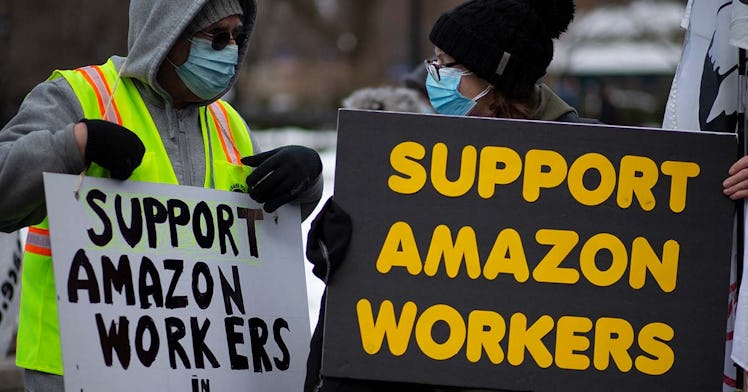The Teamsters Are Going to Try to Unionize Amazon Workers
Amazon's dominance is hurting logistics and delivery workers across the industry. The Teamsters are ready to fight back.

The coming showdown between the International Brotherhood of Teamsters and Amazon will be a heavyweight battle. The fourth-largest union in the United States is primed to pass a special resolution to organize workers at the second-largest private employer in the country, one infamous for shady labor practices and union-busting tactics.
The resolution, whose existence was first reported by Vice, pulls no punches: “Amazon exploits its employees, contractors, and employees of contractors via: wage theft, fraudulent classification, intense production quotas, dehumanizing work environments, unsafe workplaces and production standards, low wages, high turnover, no voice on the job, lack of job security and outsourced jobs.”
Organizing Amazon’s hourly workers is important to the Teamsters for reasons of solidarity, of course.
Here’s Why It Matters for Workers, and Working Parents
But another important goal of the “Amazon Project” is to protect existing Teamsters from the erosion of worker benefits that Amazon has brought to the logistics industry. This matters for parents across the logistics industry, whether they work in Amazon warehouses or elsewhere. Teamsters have reported more weekend and holiday shifts, unpredictable schedules, higher quotas, and more reliance on non-temps and contractors who lack union protection, changes driven by competition with Amazon. Unionizing will protect workers across the industry — no small part of whom are feeding families on their wages — and help create a better, healthier economy.
While Amazon is often eager to compare its $15 minimum wage to lower figures at Walmart and other big-box retailers, the more apt comparison is to what workers doing similar jobs in logistics and delivery make. The Vice story includes interviews with Teamsters who operate forklifts and make deliveries and make $29 and $39 an hour, respectively. They also have pensions and healthcare benefits and better working conditions, all conditions won by unions.
A recent New York Times feature on an Amazon warehouse in Staten Island uncovered an incompetent HR department, leadership that was less than transparent about COVID-19 infections, and a culture that makes unfair demands of workers.
The investigation also found that Amazon’s turnover rate is much higher than those of other companies in the industry. In 2019, it hired more than 770,000 hourly workers while the number of workers at the company grew by just 150,000. That means the company lost (via quitting or firing) and then replaced a number of workers nearly equivalent to its entire 650,000-person workforce. Stable employment is deeply important for workers.
Unions Help Families Thrive
Because of the high rate of turnover and lack of available data, we don’t know how many Amazon workers are parents who use their wages to support their families, though, in 2019, some 1,800 moms at the company made national news while demanding backup daycare for their work.
What we do know is that unions are good for working families, as unionizing means higher wages, smaller gender and racial wage gaps, and a non-company-controlled system to register grievances and bargain collectively.
Unionizing Amazon would have a real impact on workers at its more than 100 fulfillment centers spread across 42 states. It would also mean a loss of money and power for the company, which will certainly oppose the Teamsters at every turn.
Amazon successfully (and perhaps illegally) defeated a union drive at a warehouse in Bessemer, Alabama earlier this year that used the standard National Labor Relations Board election process. The Teamsters doesn’t plan to use that process, opting instead for work stoppages, petitions, and similar collection actions that don’t require organizing warehouses individually and don’t leave the company with as much latitude to deliver anti-union propaganda to its employees.
“We chose not to go down the path of an NLRB election for the reasons that were validated in the Bessemer union election,” Randy Korgan, who is leading the effort for the Teamsters, told Vice. “At the same time, the Bessemer workers’ message was heard by millions of workers in their position who realized, ‘Oh there’s something I can do about this.’ The list is very long in how workers can seek justice on the job. The NLRB is not the only way.”
Teamsters leadership will vote tomorrow on whether to adopt the resolution and begin what will be a long struggle that, if successful, could change the lives of workers around the country.